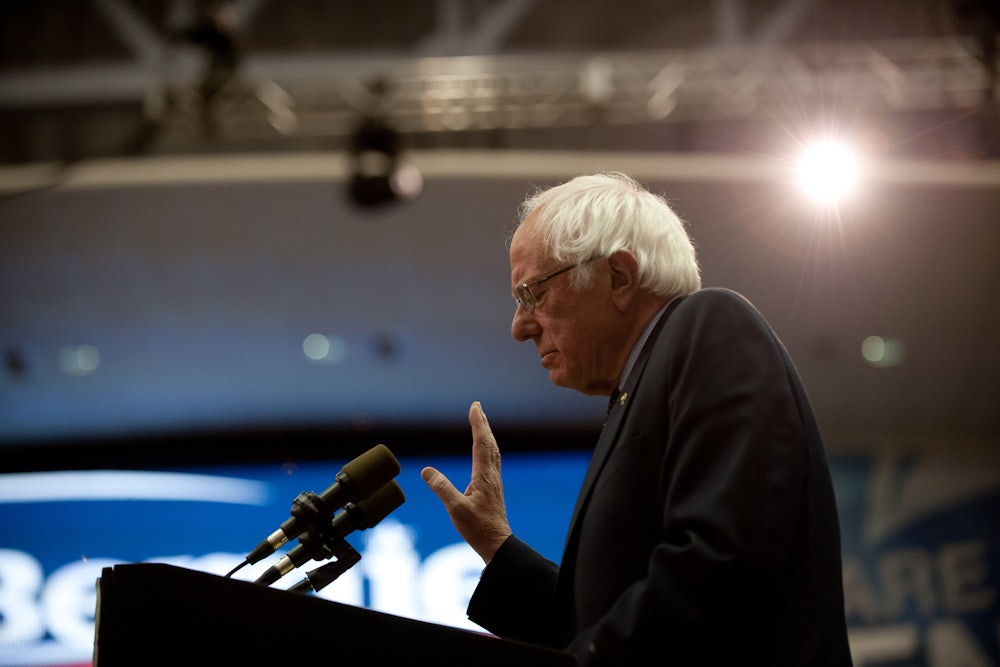For Bernie Sanders, his loss in New York’s Democratic primary must be sobering. Hillary Clinton beat him by 16 percent, worse than expected. Moreover, while Sanders can reasonably complain that the rules set up by the party, requiring voters to be registered as Democrats months in advance, were onerous and disenfranchising, he has to contend with the fact that voter turnout was high. This cuts against Sanders’s claim that he’s attracting the most enthusiastic followers.
Sanders’s campaign had been on a winning streak lately, capturing seven of the last eight states. The national polls have been tightening, and Sanders has been outperforming expectations. While there’s a tendency on the part of the media to dismiss Sanders as already too far behind to catch up, the fact is that he has done far better than anyone would have predicted. He faces long, but not impossible odds.
It’s precisely because winning is still a option that the Sanders campaign has taken a much more aggressive tone lately. He has questioned Clinton’s qualifications to be president, although he later softened that by saying he questioned her judgment. Sanders’s campaign has been more vocal about calling attention to Clinton’s reliance on big-money donors, and his supporters recently picketed a recent Clinton fundraiser. The hearty congeniality of the early days of the campaign are gone, with Sanders and Clinton much more likely to snip at each other in debates and on the trail.
While the loss in the New York doesn’t mark the end of Sanders’s campaign, his odds of winning became much longer. Upcoming delegate-rich states like Pennsylvania and Maryland favor Clinton. On Tuesday night, Sanders consultant Tad Devine said that after the next Tuesday’s primaries in Pennsylvania, Maryland, Delaware, Rhode Island, and Connecticut, the campaign will “assess where we are.”
So Sanders has to decide when he will make the pivot from an aggressive outsider who’s trying to take down the frontrunner to a loyal party member who will support the winner.
If Sanders stays negative as his chances of winning dwindle, he’ll burn bridges and be shut out of the party. By further damaging Clinton ahead of the general election, he runs the risk of being seen as a Ralph Nader–like spoiler.
The other alternative is to revert to the civic idealism of the early days of his campaign, which aimed to reform the Democratic Party from within.
The case for staying negative is that Sanders can highlight genuine problems with the primary system, which is plagued by arbitrary rules. Given Sanders’s long time as an independent rather than a Democrat, it might be easier for him to return to the role of the prophet in the wilderness castigating the system.
Yet as he himself notes, Sanders’s years in politics have also shown him to be someone who knows how to work with others and push forward a positive agenda. Given that a strong minority in the party love him, he is in a position to leverage his campaign to be a real power broker in the party and push the Clinton campaign to the left.
Sanders has been a surprise contender, and it’s easy to engage in might-have-beens or alternative history scenarios. But a healthier way to think about the Sanders campaign is in terms of what it bodes for the future. He has proven there is a large space to the left of Clinton in the Democratic Party. In the future, his electoral weak spots could be addressed by a candidate who has a similar message but pitches it to a broader audience. The Achilles heel of his campaign has been Southern blacks. But there is not intuitive reason why this group should be immune to a message of economic populism. Indeed, Jesse Jackson showed in 1988 that it could be done.
The Sanders campaign should be seen not as a failed gambit but as a road map to the future of the Democratic Party. If a candidate can combine Sanders’s economic populism with the ability to articulate that message in the South, then the future will belong Sanders, and Clinton’s triumph will be seen as the last gasp of the centrism that dominated the party in the long aftermath of Reaganism.
Correction: An earlier version of this article alluded to the “hurdles the New York Democratic Party has placed on voting.” The early deadline to switch party affiliation is dictated by state law.
